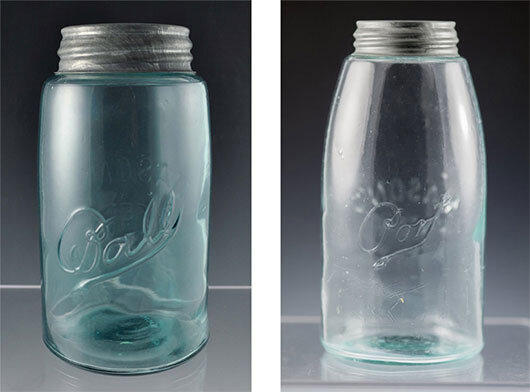Out Of the Mold
In 1880 a small business was launched in Buffalo, NY. Making tin cans to hold kerosene and paint, the modest business soon redesigned their product and expanded into glass production. It wasn’t long before the company’s fruit jars were outselling their kerosene cans. Looking to capitalize on the area’s natural gas supply, the company opened a glass factory in Muncie. This move proved successful.
This 1932 cover of The Ball Blue Book depicts two of the company’s fruit jars – The Perfect Mason and the Ideal. Minnetrista Heritage Collection
Production grew throughout the 1890s, and to keep up with consumer demands, Ball Brothers acquired several other glass companies. By 1904 Ball was operating glass plants around Indiana as well as in Illinois and Kansas. Not a company to waste resources, they often reworked the machines at their acquired plants to incorporate their brand on the former company’s design. This led to a variety of jars that looked out of the typical mold, but still proudly carried the name Ball.
The Ball logo has undergone many changes during its long history. A long-standing element has been a variation of the upward script.
In the Minnetrista Heritage Collection we have several examples of Ball jars made on molds that were obtained by Ball Brothers during these acquisitions. We also have examples of jars made by the original company prior to the alteration of the machines. Comparing the two side by side you can easily see how a skilled mold maker was able to adapt the original design to add the Ball name. In many instances this resulted in a variation of Ball’s iconic script. In others, the outcome was a completely different look.
The jar on the right was made by Port Glass Works around 1903. The Ball jar on the left was made at the former Port plant on an altered “Port” mold. Minnetrista Heritage Collection
In 1904 Ball Brothers acquired the Port Glass Works of Belleville, IL, and operated the plant until 1910. The jars seen above were both made in Belleville. Looking closely you can see how the “Port” script was remade into a variation of the “Ball” script. The distinctive shape of the “P” easily translates into the “B” of Ball.
The Boyd brand mason jar on the right was made by Greenfield Fruit Jar & Bottle Company around 1909. The Ball mason jar was made between 1910 and 1914. Minnetrista Heritage Collection
The 1909 purchase of the Greenfield Fruit Jar & Bottle Company provided Ball Brothers with a manufacturing plant in Greenfield, IN. Although Ball had been using their signature logo for years, the jars they made on reworked molds at Greenfield did not utilize their trademark upward script. Following the existing design, the Boyd brand jars made by Greenfield were altered to read “Ball” as can be seen in the above images.
Between 1906 and 1909 The Mason Fruit Jar & Bottle Company made jars simply marked “The Mason.” From 1909–1911 Ball Brothers made this altered version of “The Mason.” Minnetrista Heritage Collection
When Ball Brothers bought The Mason Fruit Jar & Bottle Company of Coffeyville, KS in 1909, they altered the molds in Coffeyville as they had done in Greenfield and Belleville. Rather than change an existing name to read Ball, this time they simply added their brand to the product. After a failure in the natural gas supply in Coffeyville, the site was abandoned in 1913.
Many other glass companies were bought out by Ball in the first part of the 20th century. These purchases produced products resembling the former company’s wares as well. A selection of these reworked jars can be seen at Minnetrista through February 22. When you arrive, head up to the atrium to check out these and other gems from the Heritage Collection!




